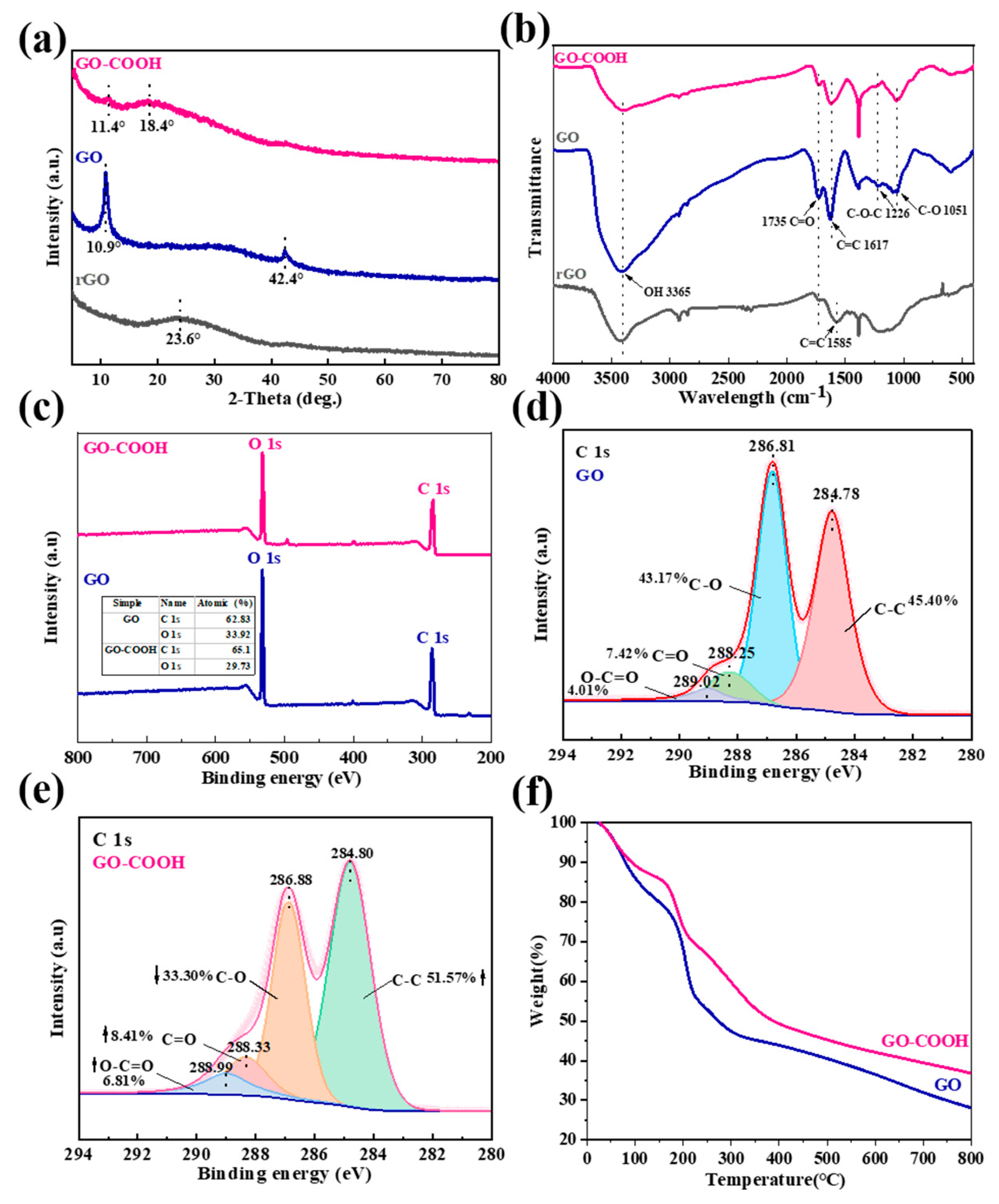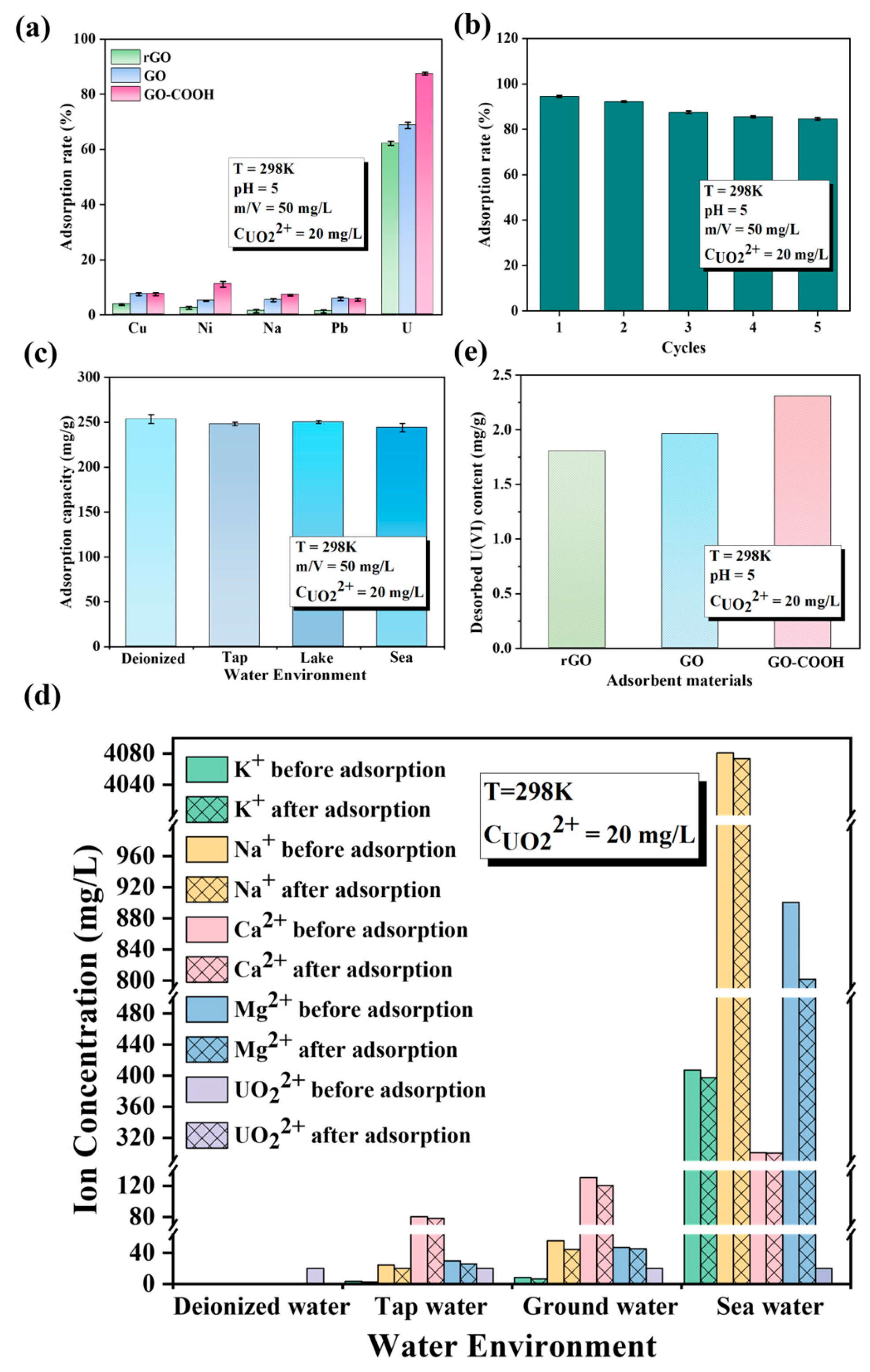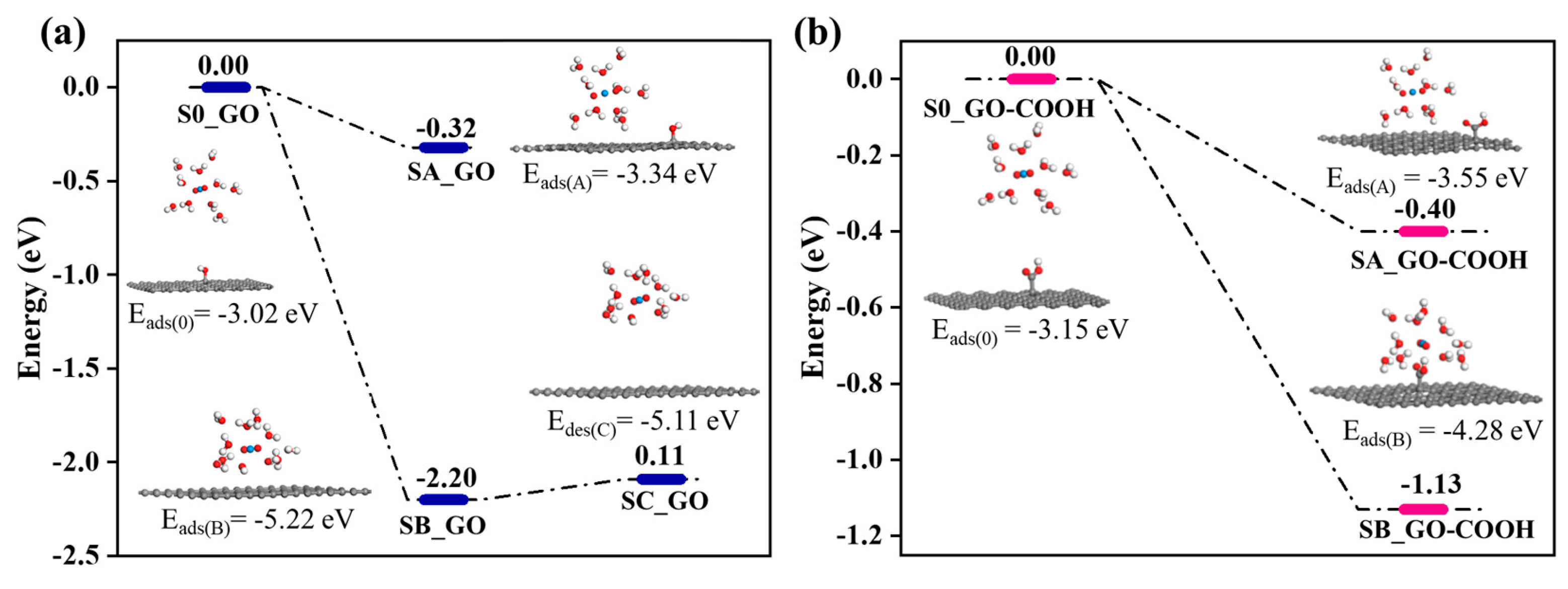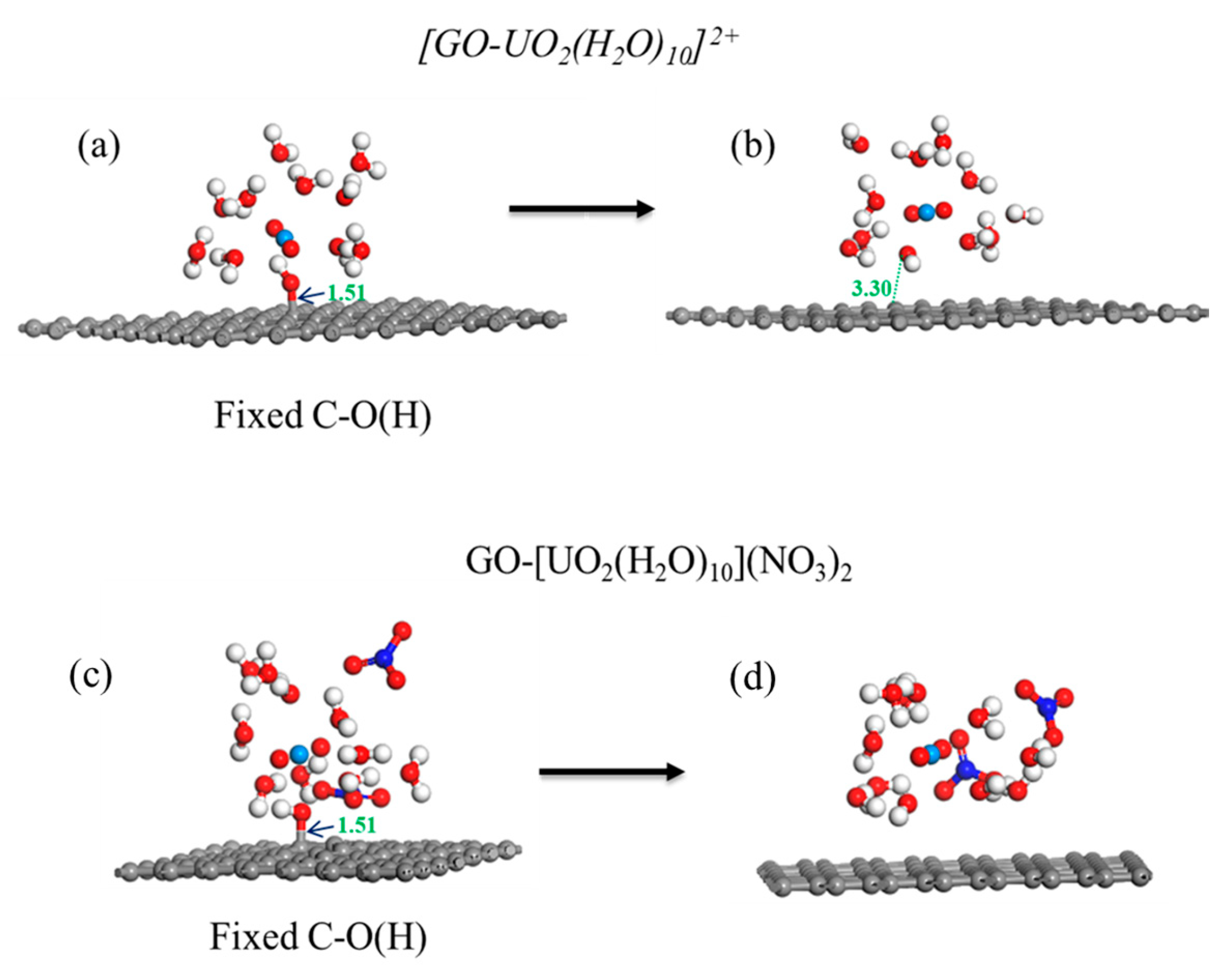How to Evaluate the Chemical Affinity of -OH and -COOH Functional Groups Toward U(VI)
Abstract
:1. Introduction
2. Experimental Sections
2.1. Synthesis of Graphene Oxide (GO) and Simple Thermal Reduced GO (rGO)
2.2. Synthesis of Carboxylated Graphene Oxide (GO-COOH)
3. Computational Details
4. Results and Discussion
4.1. Characterization
4.2. Batch Adsorption Studies
4.3. Adsorption Mechanism
4.4. DFT Calculation
5. Materials and Methods
5.1. Materials
5.2. Adsorption Study
6. Conclusions
Author Contributions
Funding
Institutional Review Board Statement
Informed Consent Statement
Data Availability Statement
Conflicts of Interest
References
- Yuan, D.; Chen, L.; Xiong, X.; Yuan, L.; Liao, S.; Wang, Y. Removal of uranium (VI) from aqueous solution by amidoxime functionalized superparamagnetic polymer microspheres prepared by a controlled radical polymerization in the presence of DPE. Chem. Eng. J. 2016, 285, 358–367. [Google Scholar] [CrossRef]
- Anirudhan, T.S.; Bringle, C.D.; Rijith, S. Removal of uranium(VI) from aqueous solutions and nuclear industry effluents using humic acid-immobilized zirconium-pillared clay. J. Environ. Radioact. 2010, 101, 267–276. [Google Scholar] [CrossRef] [PubMed]
- Li, B.; Bai, C.; Zhang, S.; Zhao, X.; Li, Y.; Wang, L.; Ding, K.; Shu, X.; Li, S.; Ma, L. An adaptive supramolecular organic framework for highly efficient separation of uranium via an in situ induced fit mechanism. J. Mater. Chem. A 2015, 3, 23788–23798. [Google Scholar] [CrossRef]
- Liao, S.; Li, Y.; Cheng, J.; Yu, J.; Ren, W.; Yang, S. Active and selective removal of U(VI) from contaminated water by plasma-initiated polymerization of aniline/GO. J. Mol. Liq. 2021, 344, 117687. [Google Scholar] [CrossRef]
- Abdi, M.R.; Shakur, H.R.; Rezaee Ebrahim Saraee, K.; Sadeghi, M. Effective removal of uranium ions from drinking water using CuO/X zeolite based nanocomposites: Effects of nano concentration and cation exchange. J. Radioanal. Nucl. Chem. 2014, 300, 1217–1225. [Google Scholar] [CrossRef]
- Shen, J.; Cao, F.; Liu, S.; Wang, C.; Chen, R.; Chen, K. Effective and selective adsorption of uranyl ions by porous polyethylenimine-functionalized carboxylated chitosan/oxidized activated charcoal composite. Front. Chem. Sci. Eng. 2021, 16, 408–419. [Google Scholar] [CrossRef]
- Cui, W.; Zhang, C.; Jiang, W.; Li, F.; Liang, R.; Liu, J.; Qiu, J. Regenerable and stable sp2 carbon-conjugated covalent organic frameworks for selective detection and extraction of uranium. Nat. Commun. 2020, 11, 436. [Google Scholar] [CrossRef]
- Li, M.; Liu, H.; Chen, T.; Dong, C.; Sun, Y. Synthesis of magnetic biochar composites for enhanced uranium(VI) adsorption. Sci. Total Environ. 2019, 651, 1020–1028. [Google Scholar] [CrossRef]
- Yang, W.; Cao, M. Study on the difference in adsorption performance of graphene oxide and carboxylated graphene oxide for Cu(II), Pb(II) respectively and mechanism analysis. Diam. Relat. Mater. 2022, 129, 109332. [Google Scholar] [CrossRef]
- Bai, Z.; Yuan, L.; Zhu, L.; Liu, Z.; Chu, S.; Zheng, L.; Zhang, J.; Chai, Z.; Shi, W. Introduction of amino groups into acid-resistant MOFs for enhanced U(VI) sorption. J. Mater. Chem. A 2015, 3, 525–534. [Google Scholar] [CrossRef]
- Sachs, S.; Reich, T.; Bernhard, G. Study of the role of sulfur functionalities in humic acids for uranium(VI) complexation. Radiochim. Acta 2010, 98, 467–477. [Google Scholar] [CrossRef]
- Badsha, M.A.H.; Khan, M.; Wu, B.; Kumar, A.; Lo, I.M.C. Role of surface functional groups of hydrogels in metal adsorption: From performance to mechanism. J. Hazard Mater. 2021, 408, 124463. [Google Scholar] [CrossRef] [PubMed]
- Kim, J.; Tsouris, C.; Mayes, R.T.; Oyola, Y.; Saito, T.; Janke, C.J.; Dai, S.; Schneider, E.; Sachde, D. Recovery of Uranium from Seawater: A Review of Current Status and Future Research Needs. Sep. Sci. Technol. 2013, 48, 367–387. [Google Scholar] [CrossRef]
- Awad, F.S.; AbouZied, K.M.; Abou El-Maaty, W.M.; El-Wakil, A.M.; Samy El-Shall, M. Effective removal of mercury(II) from aqueous solutions by chemically modified graphene oxide nanosheets. Arab. J. Chem. 2020, 13, 2659–2670. [Google Scholar] [CrossRef]
- Skorupskii, G.; Trump, B.A.; Kasel, T.W.; Brown, C.M.; Hendon, C.H.; Dinca, M. Efficient and tunable one-dimensional charge transport in layered lanthanide metal-organic frameworks. Nat. Chem. 2020, 12, 131–136. [Google Scholar] [CrossRef]
- Gamov, G.A.; Zavalishin, M.N.; Pimenov, O.A.; Klochkov, V.V.; Khodov, I.A. La(III), Ce(III), Gd(III), and Eu(III) Complexation with Tris(hydroxymethyl)aminomethane in Aqueous Solution. Inorg. Chem. 2020, 59, 17783–17793. [Google Scholar] [CrossRef]
- Taha-Tijerina, J.; Venkataramani, D.; Aichele, C.P.; Tiwary, C.S.; Smay, J.E.; Mathkar, A.; Chang, P.; Ajayan, P.M. Quantification of the Particle Size and Stability of Graphene Oxide in a Variety of Solvents. Part. Part. Syst. Charact. 2014, 32, 334–339. [Google Scholar] [CrossRef]
- Yang, S.; Chen, C.; Chen, Y.; Li, J.; Wang, D.; Wang, X.; Hu, W. Competitive Adsorption of Pb(II), Ni(II), and Sr(II) Ions on Graphene Oxides: A Combined Experimental and Theoretical Study. Chempluschem 2015, 80, 480–484. [Google Scholar] [CrossRef]
- Fooladi, E.; Razavizadeh, B.M.; Noori, M.; Kakooei, S. Application of carboxylic acid-functionalized of graphene oxide for electrochemical simultaneous determination of tryptophan and tyrosine in milk. SN Appl. Sci. 2020, 2, 527. [Google Scholar] [CrossRef]
- Chen, S.; Zheng, F.; Feng, J.; Dong, H.; Li, Y. Theoretical study on single-side fluorinated graphene for lithium storage. Appl. Surf. Sci. 2021, 560, 150033. [Google Scholar] [CrossRef]
- Grimme, S. Semiempirical GGA-type density functional constructed with a long-range dispersion correction. J. Comput. Chem. 2006, 27, 1787–1799. [Google Scholar] [CrossRef] [PubMed]
- Ju, H.; Huh, S.; Choi, S.; Lee, H. Structures of thermally and chemically reduced graphene. Mater. Lett. 2010, 64, 357–360. [Google Scholar] [CrossRef]
- Zhao, L.; Yang, S.; Feng, S.; Ma, Q.; Peng, X.; Wu, D. Preparation and Application of Carboxylated Graphene Oxide Sponge in Dye Removal. Int. J. Env. Res. Public Health 2017, 14, 1301. [Google Scholar] [CrossRef]
- Peng, T.; Liu, B.; Gao, X.; Luo, L.; Sun, H. Preparation, quantitative surface analysis, intercalation characteristics and industrial implications of low temperature expandable graphite. Appl. Surf. Sci. 2018, 444, 800–810. [Google Scholar] [CrossRef]
- Farooq, S.; Aziz, H.; Ali, S.; Murtaza, G.; Rizwan, M.; Saleem, M.H.; Mahboob, S.; Al-Ghanim, K.A.; Riaz, M.N.; Murtaza, B. Synthesis of Functionalized Carboxylated Graphene Oxide for the Remediation of Pb and Cr Contaminated Water. Int. J. Env. Res. Public Health 2022, 19, 10610. [Google Scholar] [CrossRef]
- Kobets, A.A.; Iurchenkova, A.A.; Asanov, I.P.; Okotrub, A.V.; Fedorovskaya, E.O. Redox Processes in Reduced Graphite Oxide Decorated by Carboxyl Functional Groups. Phys. Status Solidi (B) 2019, 256, 1800700. [Google Scholar] [CrossRef]
- Peng, W.; Li, H.; Liu, Y.; Song, S. A review on heavy metal ions adsorption from water by graphene oxide and its composites. J. Mol. Liq. 2017, 230, 496–504. [Google Scholar] [CrossRef]
- Chen, X.; Wang, X.; Fang, D. A review on C1s XPS-spectra for some kinds of carbon materials. Fuller. Nanotub. Carbon Nanostructures 2020, 28, 1048–1058. [Google Scholar] [CrossRef]
- Imani, R.; Emami, S.H.; Faghihi, S. Nano-graphene oxide carboxylation for efficient bioconjugation applications: A quantitative optimization approach. J. Nanoparticle Res. 2015, 17, 88. [Google Scholar] [CrossRef]
- Jasim, D.A.; Lozano, N.; Kostarelos, K. Synthesis of few-layered, high-purity graphene oxide sheets from different graphite sources for biology. 2D Mater. 2016, 3, 014006. [Google Scholar] [CrossRef]
- Mohamud, H.; Ivanov, P.; Russell, B.C.; Regan, P.H.; Ward, N.I. Selective sorption of uranium from aqueous solution by graphene oxide-modified materials. J. Radioanal. Nucl. Chem. 2018, 316, 839–848. [Google Scholar] [CrossRef] [PubMed]
- Wang, Y.; Wang, Z.; Ang, R.; Yang, J.; Liu, N.; Liao, J.; Yang, Y.; Tang, J. Synthesis of amidoximated graphene oxide nanoribbons from unzipping of multiwalled carbon nanotubes for selective separation of uranium(vi). RSC Adv. 2015, 5, 89309–89318. [Google Scholar] [CrossRef]
- Tokunaga, T.K.; Kim, Y.; Wan, J.; Yang, L. Aqueous Uranium(VI) Concentrations Controlled by Calcium Uranyl Vanadate Precipitates. Environ. Sci. Technol. 2012, 46, 7471–7477. [Google Scholar] [CrossRef] [PubMed]
- Bi, H.; Luo, Y.; Zhao, C.; Ma, L.; Huang, H. Graphene oxide suspension-based electrolyte promotes the cycling performance of aqueous sodium-ion batteries through the interaction between metal ions, free water molecules and functional groups. J. Power Sources 2023, 555, 232380. [Google Scholar] [CrossRef]
- Yang, S.; Du, X. Enhanced dispersion of carbon nanotubes in water by plasma induced graft poly(N,N-dimethylacrylamide) and its application in humic acid capture. J. Mol. Liq. 2019, 277, 380–387. [Google Scholar] [CrossRef]
- Zhou, X.; Liu, W.; Zhang, J.; Wu, C.; Ou, X.; Tian, C.; Lin, Z.; Dang, Z. Biogenic Calcium Carbonate with Hierarchical Organic-Inorganic Composite Structure Enhancing the Removal of Pb(II) from Wastewater. ACS Appl. Mater. Interfaces 2017, 9, 35785–35793. [Google Scholar] [CrossRef]
- Lyubchik, S.I.; Lyubchik, A.I.; Galushko, O.L.; Tikhonova, L.P.; Vital, J.; Fonseca, I.M.; Lyubchik, S.B. Kinetics and thermodynamics of the Cr(III) adsorption on the activated carbon from co-mingled wastes. Colloids Surf. A Physicochem. Eng. Asp. 2004, 242, 151–158. [Google Scholar] [CrossRef]
- Chen, L.; Zhao, D.; Chen, S.; Wang, X.; Chen, C. One-step fabrication of amino functionalized magnetic graphene oxide composite for uranium(VI) removal. J. Colloid Interface Sci. 2016, 472, 99–107. [Google Scholar] [CrossRef]
- Zhao, Y.; Li, J.; Zhang, S.; Chen, H.; Shao, D. Efficient enrichment of uranium(VI) on amidoximated magnetite/graphene oxide composites. RSC Adv. 2013, 3, 18952–18959. [Google Scholar] [CrossRef]
- Shao, L.; Zhong, J.; Ren, Y.; Tang, H.; Wang, X. Perhydroxy-CB/6 decorated graphene oxide composite for uranium(VI) removal. J. Radioanal. Nucl. Chem. 2016, 311, 627–635. [Google Scholar] [CrossRef]
- Song, W.; Wang, X.; Wang, Q.; Shao, D.; Wang, X. Plasma-induced grafting of polyacrylamide on graphene oxide nanosheets for simultaneous removal of radionuclides. Phys. Chem. Chem. Phys. 2015, 17, 398–406. [Google Scholar] [CrossRef] [PubMed]
- Yang, A.; Yang, P.; Huang, C.P. Preparation of graphene oxide–chitosan composite and adsorption performance for uranium. J. Radioanal. Nucl. Chem. 2017, 313, 371–378. [Google Scholar] [CrossRef]
- Duan, S.; Wang, Y.; Liu, X.; Shao, D.; Hayat, T.; Alsaedi, A.; Li, J. Removal of U(VI) from Aqueous Solution by Amino Functionalized Flake Graphite Prepared by Plasma Treatment. ACS Sustain. Chem. Eng. 2017, 5, 4073–4085. [Google Scholar] [CrossRef]
- Verma, S.; Dutta, R.K. A facile method of synthesizing ammonia modified graphene oxide for efficient removal of uranyl ions from aqueous medium. RSC Adv. 2015, 5, 77192–77203. [Google Scholar] [CrossRef]
- Zheng, N.; Yin, L.; Su, M.; Liu, Z.; Tsang, D.C.W.; Chen, D. Synthesis of shape and structure-dependent hydroxyapatite nanostructures as a superior adsorbent for removal of U(VI). Chem. Eng. J. 2020, 384, 123262. [Google Scholar] [CrossRef]
- Liu, X.; Li, J.; Wang, X.; Chen, C.; Wang, X. High performance of phosphate-functionalized graphene oxide for the selective adsorption of U(VI) from acidic solution. J. Nucl. Mater. 2015, 466, 56–64. [Google Scholar] [CrossRef]













| Adsorbents | Pseudo-First Order | Pseudo-Second Order | ||||
|---|---|---|---|---|---|---|
| R12 | k1 | Q1e | R22 | k2 | Q2e | |
| GO-COOH | 0.978 | 0.368 | 243.21 | 0.997 | 0.0029 | 251.77 |
| T(K) | Langmuir | Freundlich | ||||
|---|---|---|---|---|---|---|
| R2 | KL (L/mg) | Qm | R2 | KF (mg/g) | n | |
| 298 | 0.981 | 0.941 | 304.133 | 0.857 | 169.795 | 6.646 |
| 308 | 0.984 | 1.916 | 322.734 | 0.835 | 198.304 | 7.588 |
| 318 | 0.954 | 3.107 | 344.130 | 0.862 | 221.669 | 8.076 |
| T(K) | Kd | ΔG0 (kJ·mol−1) | ΔH0 (kJ·mol−1) | ΔS0 (J·mol−1K−1) |
|---|---|---|---|---|
| 298 | 26.045 | −8.141 | ||
| 308 | 34.693 | −8.940 | 15.672 | 79.91 |
| 318 | 38.702 | −9.739 |
| Adsorbent | Adsorption Conditions | Qmax | References | ||
|---|---|---|---|---|---|
| pH | T (K) | m/v (mg/L) | (mg/g) | ||
| Fe3O4/graphene oxide | 5 | 293 | 50 | 69.5 | [38] |
| Amidoximated magnetite/GO | 5 | 298 | 200 | 284.9 | [39] |
| HO-CB(6)/GO | 5 | 298 | 100 | 301.6 | [40] |
| PAM/GO composites | 5 | 295 | 200 | 166.2 | [41] |
| GO-CTS | 5 | 298 | 1000 | 50.51 | [42] |
| PTFG-4 | 6 | 293 | 250 | 140.7 | [43] |
| NH3-GO | 6 | 298 | 1000 | 80.13 | [44] |
| GO-COOH | 5 | 298 | 50 | 344.1 | This work |
Disclaimer/Publisher’s Note: The statements, opinions and data contained in all publications are solely those of the individual author(s) and contributor(s) and not of MDPI and/or the editor(s). MDPI and/or the editor(s) disclaim responsibility for any injury to people or property resulting from any ideas, methods, instructions or products referred to in the content. |
© 2024 by the authors. Licensee MDPI, Basel, Switzerland. This article is an open access article distributed under the terms and conditions of the Creative Commons Attribution (CC BY) license (https://creativecommons.org/licenses/by/4.0/).
Share and Cite
Cui, X.; Xie, X.; Li, Y.; Chen, Y.; Ma, Y.; Yang, S. How to Evaluate the Chemical Affinity of -OH and -COOH Functional Groups Toward U(VI). Molecules 2024, 29, 5614. https://doi.org/10.3390/molecules29235614
Cui X, Xie X, Li Y, Chen Y, Ma Y, Yang S. How to Evaluate the Chemical Affinity of -OH and -COOH Functional Groups Toward U(VI). Molecules. 2024; 29(23):5614. https://doi.org/10.3390/molecules29235614
Chicago/Turabian StyleCui, Xuemei, Xiaoying Xie, Yun Li, Yue Chen, Yan Ma, and Shubin Yang. 2024. "How to Evaluate the Chemical Affinity of -OH and -COOH Functional Groups Toward U(VI)" Molecules 29, no. 23: 5614. https://doi.org/10.3390/molecules29235614
APA StyleCui, X., Xie, X., Li, Y., Chen, Y., Ma, Y., & Yang, S. (2024). How to Evaluate the Chemical Affinity of -OH and -COOH Functional Groups Toward U(VI). Molecules, 29(23), 5614. https://doi.org/10.3390/molecules29235614






